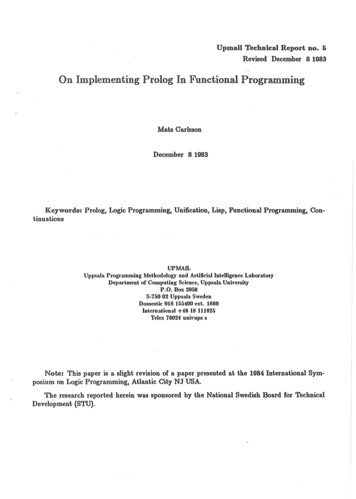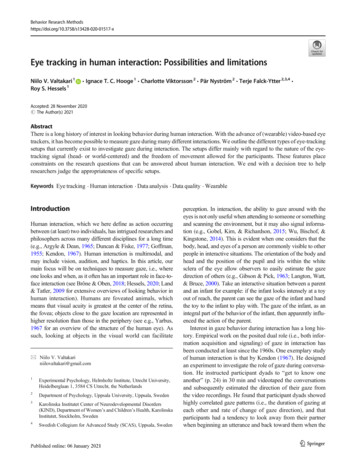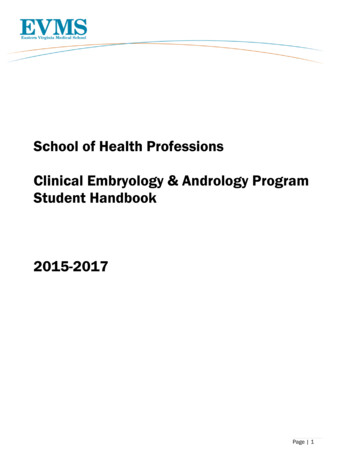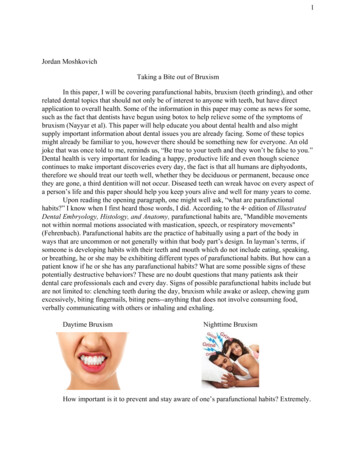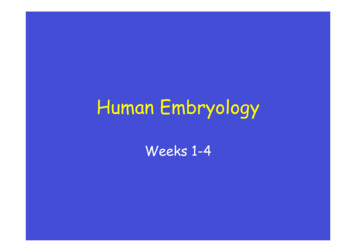
Transcription
Human EmbryologyWeeks 1-4
Week 1Fertilisation to ImplantationFor this presentation embryonic age will be expressed as days or weeksfrom fertilisation. On this basis human pregnancy lasts about 266 3days or 38 weeks.Obstetricians time pregnancy from the last day of the menstrual periodon the assumption that fertilisation takes place 2 weeks later. Forobstetricians pregnancy lasts 280 days or 40 weeks.
The first week of human embryonic developmentZona pellucidaAmpulladiameter of the uterine tube 1-2 cmdiameter of the zygote 0.12 mm
Human embryos in the first week of developmentzonapellucidainner cell mass orfuture embryotrophoblastor future placenta2 cells 24 hoursoocytefertilised eggor zygote – 2nuclei egg andsperm58 cells 5days2-cell stage8-cell stage(3 days)107cells 6 daysmorulaEmbryo “hatching”From the zonapellucidablastocyst
Three day old embryos
ImplantationTo implant the developing embryo must pass through the uterineepithelium. This occurs about 7 days after fertilisation. Thetrophoblast produceshuman chorionic gonadotropin (hCG) which maintains the corpus luteum ofthe ovary which in turn produces progestesterone which maintains earlypregnancy. hCG can be detected in the maternal blood and forms thebasis of the early pregnancy test. Detection in urine is less sensitive.
Ectopic Pregnancies Implantation in a nonuterine site occurs at arate of about 0.25 – 1%. The ampulla of the uterinetube is the most commonectopic implantation site.
In vitro fertilisation The process by which one or more eggs(oocytes)oocytes) are fertilised outside thebody. Fertilisation is either achievedby placing a droplet of washed sperm( 50,000) onto each egg or if thesperm count is low a single sperm canbe injected into each egg (IntraCytoplasmic Sperm Injection – ICSI).oocytefertilised egg(zygote)4-cell embryo Embryos can be placed into the uterusat the 6-8 cell stage (3-days culture)but some clinics culture the embryosfor 5 or 6 days to ensure healthyblastocyst stage embryos are placedinto the uterus.blastocyst
IVF and Preimplantation Genetic Diagnosis All cells in the early embryo (untilabout the 8-cell stage) are said tobe totipotent.totipotent. That means thateach cell is capable of forming acomplete human. So couples using IVF can usegenetic screening of theirembryos by having a cell removedfrom their embryo(s)embryo(s) and testedfor its genotype. The embryo willstill develop normally. More than 100 diseases can bedetected including hemophilia A,muscular dystrophy, Tay-Sachsdisease, cystic fibrosis and Downsyndrome.
Stem Cell Research Stem cells are unspecialized cells that can renewthemselves for long periods through cell division.Under certain experimental conditions, they can beinduced to become cells with special functionssuch as the beating cells of the heart muscle or theinsulin-producing cells of the pancreas. Human embryonic stem cells are obtained from theinner cell mass – the early embryo. In the USA it is forbidden to destroy a humanembryo to obtain stem cells. So they are notallowed to remove the inner cell mass or totipotentcells. There is interest in the possibility that at the8-cell stage the cells are no longer totipotent butare still pluripotent (ie can form the 240 humancell types).
Multiple Gestations- TWINS About 1:80 human births (0.8%) is a twin pregnancy. About 2/3 of twins are fraternal (dizygotic(dizygotic)) – derived from 2 eggs. One third (1:250) are identical twins (monozygotic) 35% of MZ twins divide between 2-8 cell stage,stage, get two babies with twoamnions, two chorions,chorions, and either one fused or two separate placentascannot tell difference between these twins and fraternal until genetictesting is done.65% of MZ twins occur by division of the inner cell mass after firstweek.week. At this point two embryos will develop with two amniotic sacs, onechorionic sac and a common placenta. IVF has greatly increased the number of fraternal (dizygotic(dizygotic)) twins and in2001 the rate of twins in the USA was 3%.
Rate of twins in SwedenIn 1982 the twin rate was about 0.9%. Multiple births associated with IVF increased that rateto 1.7%.The first IVF child was born in Sweden in 1982. In early 1990s the number of embryostransferred to the uterus during IVF was reduced from 3 to 2. At present, the number ofembryos transferred is being reduced further, from 2 to 1. Källén et al BMJ 2005;331:382383
MONOZYGOTIC TWINS(a) Separation at the twoblastomere stage canlead to twinning.(b) Splitting of the innercell mass is the mostcommon cause ofidentical twins.(c) Incomplete separationof the inner cell masscan lead to conjoinedtwins.
Week 2Implantation
Human implantation1 uterine epithelium2 and 5 inner cellmass or future embryo6 -7 days7- 8 days3 and 4 trophoblast orfuture placenta3 syncytiotrophoblast4 cytotrophoblast6 yolk sac cavity8 amnion9 fibrin plug9 days9-10 ape03.html10 intervillous spaces
Implanted Human BlastocystFrom The Developing HumanMoore and Persaud 6th EditionFrom Langman’Langman’s Medical Embryology 9th EditionLippincott Williams & Wilkins
16 daysgestation21 dayscirculationestablished
16 days 4weeks 4 weeks 10 weeks 20 weeks
Week 3Gastrulation"The most important event in your life is not birth, marriage,or death, but gastrulation."- L. Wolpert.
GastrulationThe inner cell mass in the 15-16 day human embryoconsists of two layers – an upper epiblast and a lowerhypoblast. Gastrulation converts this bilaminar discinto three layers. An upper ectoderm, a middlemesoderm and a lower endoderm.14-day embryoGastrulation in a 16-day human embryo18-day embryo
Week 4Neurulation
Nervous System Development in theHuman Embryo(a)At 18 days afterconception the embryoconsists of 3 layers ofcells: endoderm,mesoderm, andectoderm. Thickeningof the ectoderm leadsto the development ofthe neural plate.(b)The neural groovebegins to develop at 20days.
Nervous System Development in theHuman Embryo(c) At 22 days theneural groove hasclosed in the middle toform the neural tube. Itremains open at eitherend.(d) The anterioropening or neuroporecloses day 25-26 andthe posterior neuroporeday 27-28.
Neural tube closure22-days24-days27-days 4mmA 27-day embryo should have a completely closed neuraltube. The heart is visible and has already started to beat.Colour photo by Lennart Nilsson
18 ig03.gif20 days22 daysSpina BifidaPicture from Illustrated guideto malformations of the CNSat birth by N. C. Nevin andJ. A. C. Weatherall 1983,Churchill Livingstone24 daysNeurulationCowan WM The Development of the Brain Sci Am 1979; 241:112
Neural tube defectsThe two neural tube defects spina bifida and anencephaly both havea prevalence of about 1:1000 live births.The chances of having a child with either of these conditions can begreatly reduced by adequate folate intake. The U.S. Public HealthService in September 1992 recommended that all women ofchildbearing age capable of becoming pregnant consume 0.4 mg offolate daily to reduce their risk of having a pregnancy affectedwith spina bifida or other neural tube defects.Use of the antiepileptic medications carbamazepine or valproic acidduring early pregnancy is associated with an increased risk ofspina bifida (perhaps 10-fold increase in risk). Folate does notappear to protect against this drug-induced birth defect.
Model of 4 week embryo 4 mm length
Weeks 5-8Organogenic Period
32- day human embryo 8 mm CR lengthOrgan system development is well underway. This isa critical time for development of the heart, limbs,eyes, upper lip, intestines.
44-day embryo 13 mm lengthAt this stage the embryo has completed much of itsorganogenesis. Still to be completed is the palate andexternal genitalia and brain development is ongoing.
8-week human fetus 3cm in lengthOrganogenesis is largely complete – development of the externalgenitalia is still incomplete. The brain is about to start an 8-weekperiod of massive neuronal cell formation for the cerebral cortex.
Weeks 9-38Fetal Period
An 8-week fetus is about 4 cm in length (crown-heel),The newborn is about 50 cm (crown-heel)
10-week human fetus 6 cm in length.Copyright 2005 Nucleus Medical ArtFetal heart beat can be monitored at this stage. Chorionicvillous sampling is usually performed between 8 and 10 weeks.A small piece (villous) of the placenta is removed and culturedin the laboratory. Genetic results are usually available in 2weeks.
13-week human fetus 10cm in length.The fetus is surrounded by about 100 ml of amniotic fluid.Amniocentesis can be performed from about 13 to 18 weeksgestation. About 10-20 ml of fluid is removed, the fetal cellsare separated and grown in culture and genetic results availablein about 2 weeks. An !-fetoprotein test can be performed onthe maternal blood. This protein is made by the fetus and is inhigher concentrations in fetuses with neural tube defects.
16-week human fetus 14cm in length,weight about 190 g.An ultrasound dating scan can be given at 5-11 weeks to confirmpregnancy, exclude ectopic or molar pregnancies, confirmcardiac pulsation and measure the crown-rump length fordating. An anomaly scan is usually performed at 16-18 weeksto look for congenital malformations. Sex of the fetus canusually be determined at this stage.
24-week human fetus 23cm in length – weight about 760g.Head hair appears, the fetus already has a downy hair (lanugo), skin is coated(lanugo),with vernix – a waxy secretion of sebaceous glands. 90% of premature babiesborn who weigh 800 g or more will survive. For those who weigh 500 g or morethere is 40-50% survival.Problems include (a) lack of body fat – difficulty keeping warm; (b) difficultyfeeding; (c) hyperbilirubinemia;hyperbilirubinemia; (d) apnea; (e) anemia; (f) respiratory distresssyndrome due to lack of lung surfactant; (g) patent ductus arteriosus;arteriosus; wth/growing/preemies.html
38 weeks – term - crown-rump length about 36cm,crown heel 50 cm – weight about 3500g.Eyes reopened at about 26 weeks, at about 30 weeksskin becomes thicker and subcutaneous fat appears.
FINISH!
Human embryonic stem cells are obtained from the inner cell mass Ð the early embryo. In the USA it is forbidden to destroy a human embryo to obtain stem cells. So they are not allowed to remove the inner cell mass or totipotent cells. There is interest in the possibility that at the 8-cell stage the cells are no longer totipotent but
